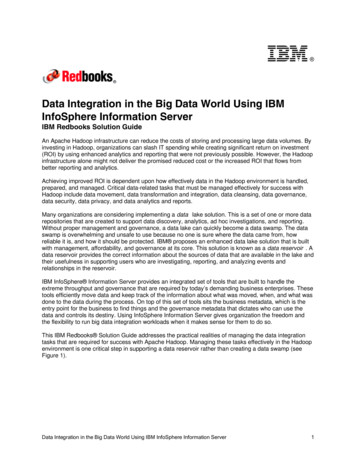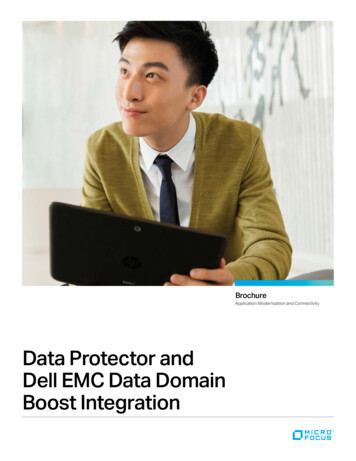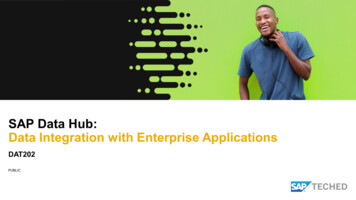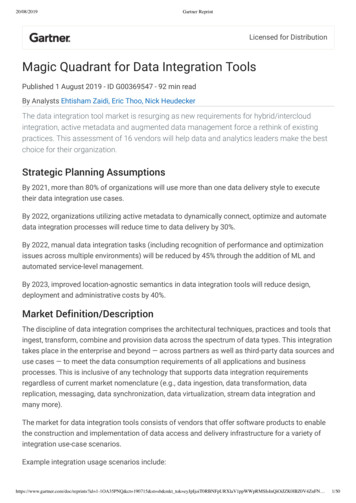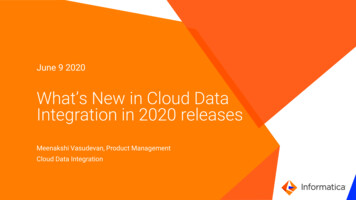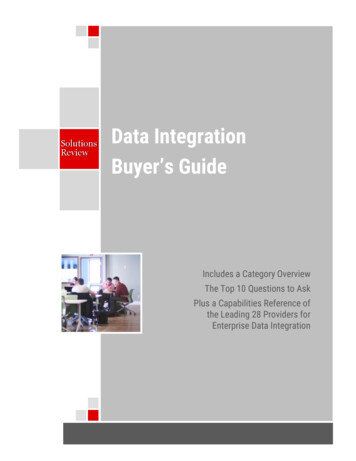
Transcription
Data IntegrationBuyer’s GuideIncludes a Category OverviewThe Top 10 Questions to AskPlus a Capabilities Reference ofthe Leading 28 Providers forEnterprise Data Integration
Data Integration2016 Buyer’s GuideanagementINTRODUCTIONData Integration tools are perhaps the most vital components to take advantage of Big Data. Enterprise organizationsincreasingly view Data Integration solutions as must-haves for assistance with data delivery, data quality, Master DataManagement (MDM), data governance, and Business Intelligence and Data Analytics. With data volumes on the rise andwith no real end in sight, businesses are leaning on integration tools more and more to meet all of the data consumptionrequirements for vital business applications. The main function of Data Integration is to give organizations the ability togain consistent access to their most important data, no matter where it lies, whether virtually or physically, whether onpremise, in the cloud, or in some other disparate location.The migration, organization, and delivery of key organizational data assets is done in such a way that allow businessteams to easily pull what they need for use within other business systems. The most comprehensive Data Integrationtools available to companies today will include data quality, data governance and MDM capabilities, providing securitythat whatever data sources that are plugged in deliver only the most relevant data for analysis. Integration tools also givecompanies the ability to ensure data consistency across applications.Accessing data doesn’t just mean having a unified view of it all, however. Forpractical purposes of crunching all the data, it needs to be in one place where ananalytics program can reach it. That involves moving data from one place toanother, usually from storage systems into a data warehouse capable of analyzingit. Methods for doing that include ETL (for Extract, Transform and Load) and DataReplication, the latter of which, while often used for tasks like Disaster Recovery andmigration, in relation to Big Data offers a high-performance data movement tool thatshould be able to quickly synchronize large quantities of data.TRENDS“In this Buyer’sGuide there’s asolution foreveryone, fromsmall groups tomulti-nationalorganizations.”In recent years, open source Big Data frameworks such as Hadoop, Spark, and NoSQL have really emerged to giveorganizations more of a choice in where they store data and run applications on clusters of hardware, giving themadditional storage options for all kinds of structured and unstructured data and enough processing power to handlevirtually an infinite number of simultaneous tasks. In addition, data lakes have gained notoriety for their ability tocontinuously collect data and store it in a lightly structured repository. This is a positive development because it can helpdeliver data to stakeholders, business processes and applications with swiftness and ease.Hadoop and friends have been able to thrive due to the demand that real-time and streaming data has put onorganizations. No longer is it enough to store data in traditional relational databases, especially considering the purevolumes of data that now come from embedded sensors, computer applications, social media activity, and mobiledevices. As more of these types of data sources become prevalent, open source storage frameworks should continue togrow in popularity, and with the Internet of Things expected to revolutionize virtually every consumer product with theaddition of data capturing, this looks like a trend that will stick around for the long haul, making integration solutions thatmuch more vital. The main consideration for buyers of integration software are features and functions of course, but DataIntegration is not so much a product as it is a process, and there a variety of ways to move the needle.Tim KingEditorSolutions Review2 2016 Solutions Review 500 West Cummings Park Woburn, Massachusetts 01801 USA2
Data Integration2016 Buyer’s Guideanagement5 Questions You Should Ask Yourself Before Selecting aData Integration SolutionQUESTION #1Why is a Data Integration tool necessary to my organization?What your company needs a program to do will determine many of the technical requirements of the DataIntegration solution that best suits you. Will you require real-time data access and transfer? How much datawill you need to move and how quickly? Can you afford some downtime on source/target systems, or doyou need them running at all times? Note that all these data requirements are based on your technical andbusiness needs so that you can compare them with what specific vendors have to offer.QUESTION #2What kind of data do I need to analyze?Is the majority of your company’s data transactional in nature? Is it all structured? If so, a traditional or“legacy” tool may be right for you. If the bulk of your data streams to your storage framework in real-time viaembedded product sensors, social media, computer applications and online customer feedback, then asolution that can integrate with the likes of Hadoop, Spark, and NoSQL is going to be the best fit for you. Besure to take into account the types of data that run through your business and then match that up with theappropriate provider.QUESTION #3What are my data sources and where are they located?The basic elements of Data Integration revolve around moving data from sources (applications) to targets(data warehouses, Hadoop, etc.). Much of what is powering the Big Data movement is the massive databeing collected in the cloud through very large Software as a Service (SaaS) solutions like Salesforce.com.Some solutions listed in this guide specialize in the integration of cloud application data with on-premisesystems to ensure that your users can access complete, current, and accurate data. Make sure the kind ofintegration you require is being offered by the vendors you are considering.QUESTION #4Cloud, on-premise, or both?A hybrid approach to Data Integration is a growing trend in the enterprise market as it providesorganizations the ability to execute integration in both on-premise and cloud environments. Thus,organizations are able to interchange data to and from either framework as a way to gain business agility totheir integration infrastructure and manage cloud data delivery and address the need for data sharingbetween cloud environments. On-premise integration is certainly not dead, but a hybrid approach will setyour organization up nicely for the future, even if cloud exposure is currently limited.QUESTION #5Are data quality and Master Data Management feature considerations?It’s one thing to use an ETL tool to move data from one storage medium to another. It’s an even differentthing to replicate a data source for use elsewhere. Most importantly, though, you’ll want to make sure thatthe appropriate data gets moved to the right place so it can be analyzed in a fashion that will yieldactionable insights. As mentioned earlier, the most comprehensive Big Data solutions today include dataquality and MDM capabilities in one form or another. With MDM as the umbrella, data governance andmanagement tools are going to be essential to you if you capture data from a wide variety of sources.3 2016 Solutions Review 500 West Cummings Park Woburn, Massachusetts 01801 USA3
Data Integration2016 Buyer’s GuideanagementAnd 5 Questions You Should Ask Your Potential DataIntegration Solution ProviderQUESTION #6Is your tool compatible with my existing infrastructure?Data Integration is of central importance to the data infrastructure of any modern digital business.Organizations want a solution that can be flexible in order to fit into an existing company framework.Synergy between any integration tool and the applications, business processes, and data sources abusiness already has in place should be the first topic addressed, and should act as qualifying questionnumber-one.QUESTION #7Is flexibility a strength of your integration solution?Enterprise organizations are increasingly interested in improving the flexibility of their data infrastructures.Thus, stakeholders are becoming aware of the kinds of integration activities that are being enacted uponvital business information. As a result, managers now understand how important Data Integration is to theircompany’s overall data management strategy. With data democratization all the rage, decision-makers areneeding to deploy integration tools that enable cross-department sharing. Fortunately for customers,vendors are taking notice of a need for flexibility, and the providers that embrace it and provide the mostcomprehensive tools will flourish in the years ahead.QUESTION #8Do you integrate with the Hadoop, Spark, and other NoSQL repositories?Chances are that if you are on the hunt for a Data Integration solution, you capture at least a moderateamount of data for analysis. The chances are also high that you use one of these storage mediums tocollect, organize, and qualify data for further use. Be sure to see if potential vendors integrate with theseopen-source Big Data frameworks, and although most do, find out to what degree each does. There aremany integration vendors out there, and even more worthy solutions. However, some are pure-play,meaning that they support traditional tools such as ETL and replication, though the move to open-source iscertainly upon us.QUESTION #9Does your solution come packaged with any support services?Consumers are increasingly expecting vendors to provide more than just a software solution. Given the lackin talent surrounding the complexities of many of the best integration tools out there, stakeholders areasking providers to include more in terms of customer support and services in the form of experts andprofessionals who can assist with deployment, integration best practices, and issues.QUESTION #10What is your main area of focus what does your tool do best?Not all solutions providers are created equal. Oftentimes, vendors will key in on a niche in the market. Byfocusing on a specific part of the space, such as cloud integration, for example, solutions providers canbecome experts at developing a narrower piece of software that although vocational, really works for itsusers. As a result, the vendor increases efficiency and overall quality and decreases the time it takes todeploy the solution organizationally.4 2016 Solutions Review 500 West Cummings Park Woburn, Massachusetts 01801 USA4
Data Integration2016 Buyer’s GuideanagementSolution Provider loverETL12Dell Boomi13HVR Software14IBM15Informatica16Information Builders17Jitterbit18Liaison 3Progress Software24SAP25SAS26Software AG28Stone Bond Technologies27Syncsort29Talend30 2016 Solutions Review 500 West Cummings Park Woburn, Massachusetts 01801 USA5
Data IntegrationActian CorporationBased in California, Actian delivers an end-to-end analytics platform thatruns entirely, and natively, in Hadoop software. Actian’ analytics platformhelps to speed up the organizational value chain by connecting with largeamounts of raw Big Data and converting between formats. The company’sopen-source solution also may be used with Spark and Hive, and enablescustomers to leverage existing investments, extend business ecosystems,and provide protection from vendor lock-in.2016 Buyer’s GuideanagementActian Software12365 Riata TraceAustin, TX 78727United States 1 888-296-5969www.actian.comFrom the Company“Actian Corporation enables organizations to transform Big Data into business value with data managementsolutions to connect, analyze, and take automated action across their business operations. Actian’s innovativeportfolio of solutions for Big Data include cloud integration for frictionless connection to any data; analyticalsolutions. In January 2013, Actian acquired Pervasive Software - a database integration software solution.Whether designing integration processes for data warehouse loading, converting data between formats,deploying complex application integration scenarios, or integrating applications both on-premises and in thecloud, Pervasive Data Integrator includes numerous foundation features that accelerate the creation of flexibleintegration solutions. Pervasive Data Integrator includes locally installed as well as cloud-based visual designersand drag-and-drop Link-Style Mapper, RIA Browser–Based User Interface, Lifecycle Management, SOA Platform,Cloud-to-Cloud Computing Interchangeable and Reusable Metadata.”Key FeaturesVortex – Provides elastic data preparation for rapid processing through analytic engines, ingestion technology,and KNIME user interfaces. Also provides SQL and predictive analytics to detect trends and patterns withhyper-parallelized operators via HadoopMatrix – A parallel, columnar, compressed, compiled approach that increases performance and algorithms, indatabase analytics, loading capacity, and accelerates processing power to provide faster delivery of MPPanalyticsVector – Enables concurrent business owners to explore data faster, and can be connected to the SMPanalytics database to any application through standard SQLBottom LinePervasive Data Integrator includes locally installed as well as cloud-based visual designers as well as Dragand-Drop Link-Style Mapper, RIA Browser–Based User Interface, Lifecycle Management, SOA Platform, Cloudto-Cloud Computing Interchangeable and Reusable Metadata.6 2016 Solutions Review 500 West Cummings Park Woburn, Massachusetts 01801 USA6
Data Integration2016 Buyer’s GuideanagementAdeptiaAdeptia is a software company based in Chicago that enables users toconnect with their customers and partners fluidly. Adeptia’s self-servicesoftware allows for digital business connectivity and enables quickresponse time between clients and company. The company’s solutionassists IT teams with management and security, and provides a hybridoffering of both cloud and on-premise enterprise integration. Adeptia’ssoftware platform is entirely web-based and can be accessed remotely.Adeptia Inc.443 North Clark StreetChicago, IL 60654United States 1 312- 229-1727www.adeptia.comFrom the Company“Adeptia was founded in June 2000, with the aim of taking business process management and integration to abroader market. Adeptia Extract, Transform & Load (ETL) Suite combines data transport with metadatamanagement and data transformation capability. It uses Service-Oriented Architecture (SOA) and a processbased model to create flexible and loosely-coupled data flows that suit any aggregation or data warehousingsolution. ETL Suite offers a middleware application to document, automate and execute critical data processesespecially for creating and populating data marts from various internal or external data sources. This allows datato be received from multiple sources in different formats and mapped to a common database schema. Thisenterprise-class software allows companies to centrally manage their data schema and mapping rules in acentral repository and directly archive those rules in PDF documents for easy sign-off.”Key FeaturesETL (Extract, Transform, Load) – Extracts data from one database, converts it, and loads it into another forbusiness analytics. Allows users to access data in real-time and transform it to suit business operations whilesimultaneously allowing IT teams to manage processes and securityFunctionality – Provides the ability to transform any number of files, such as flat files to XML, XML to CSV,Excel to Database, HIPAA to HML, HL7 to XML, etc., which enables simple aggregation and more rapidreporting and overall productivityIn-Built Job Scheduler – Real-time and batch triggers that may be built directly into any OEM solution, providingData Integration capabilities, including a job scheduler and polling eventsBottom LineAdeptia makes it easy for customers to deliver data to you, speeding up the pace of business, allowing forautomation of integration processes end-to-end, eliminating the need for manual intervention. Adeptia ETLSuite supports ANY TO ANY conversion: Flat file to XML, XML to CSV, Any Database to XML, Excel to Database,XML to EDI, HIPAA to XML, HL7 to XML, Date format, string, numerical conversions etc.7 2016 Solutions Review 500 West Cummings Park Woburn, Massachusetts 01801 USA7
Data Integration2016 Buyer’s GuideanagementAltovaAltova, a company with headquarters located in Massachusetts and Austria,provides Data Integration capabilities accessible through a graphical, dragand-drop mapping design. Their MissionKit is a software development suiteof enterprise-class XML, SQL, and UML tools for information architects andapplication developers. This suite is offered in two editions that cater tobusiness needs in order to deliver the functionality organizations require.Altova, Inc900 Cummings CenterBeverly, MA 01915United States 1 978-816-1600www.altova.comFrom the Company“Altova is a software company specializing in tools to assist developers with data management, software andapplication development, and Data Integration. The creator of XMLSpy and other XML, SQL, and UML tools,Altova is a key player in the software tools industry and a leader in XML solution development tools. AltovaMissionKit Data Integration tools provide powerful Data Integration capabilities that are easy to access via agraphical, drag-and- drop data mapping design. All of today’s prevalent data formats, including all majorrelational databases, are supported in one, affordable solution. Generation of royalty-free C#, C , Java, XSLT,and XQuery code for automating Data Integration projects, plus optional integration with Visual Studio andEclipse, give you flexible development and deployment options at no extra cost.”Key FeaturesMapForce – Map data graphically with support for XML, databases. EDI, JSON, flat files, Excel/OOXML, XBRL,and web servicesDiffDog – Allows users to compare and merge text, XML, MS Office (OOXML), directories, XML and databaseschemasStyleVision – Integrate, combine, and publish XML, database, and XBRL data with Altova’s visual design tool.This allows customers to drag-and-drop data to design reports with the ability to publish in HTML, PDF, Word,and e-FormsBottom LineAltova MapForce is an advanced integration application tool with support for integrating data with virtually anyfile format. Drag-and-drop functionality allows users to easily associate target and source data structures.Altova MissionKit database tools include support for all major relational databases in their native interfacelanguage: Microsoft SQL Server 2000, 2005, 2008, IBM DB2 8, 9, IBM DB2 for iSeries v5.4, 6.1, Oracle 9i, 10g, 11g, Sybase 12, MySQL 4, 5, PostgreSQL 8, Microsoft Access 2003, 2007.8 2016 Solutions Review 500 West Cummings Park Woburn, Massachusetts 01801 USA8
Data Integration2016 Buyer’s GuideanagementAttivoAttivio, “the Data Dexterity Company” is based in Massachusetts and offersan information access platform that uses a single query and can analyzestructured data and unstructured content. Their Active Intelligence Engine(AIE) indexes data so IT teams can dynamically access the informationfrom any location or format. Attivio’s flagship solution also provides apredictive analytics module to more efficiently analyze, search, andmanipulate data. Attivio prides themselves on empowering users to gettheir hands on the right data and work to get it to the point of informingdecisions.Attivio Inc.275 Grove StreetNewton, MA 02466United States 1 857-226-5041www.attivio.comFrom the Company“Attivio's Active Intelligence Engine (AIE) unifies the worlds of structured and semi-structured data, Big Data andunstructured content. Unlike traditional data warehouses or other information systems, AIE does not requiredefining data structures and relationships between data
Data Integration is of central importance to the data infrastructure of any modern digital business. Organizations want a solution that can be flexible in order to fit into an existing company framework. . Pervasive Data Integrator includes numer
